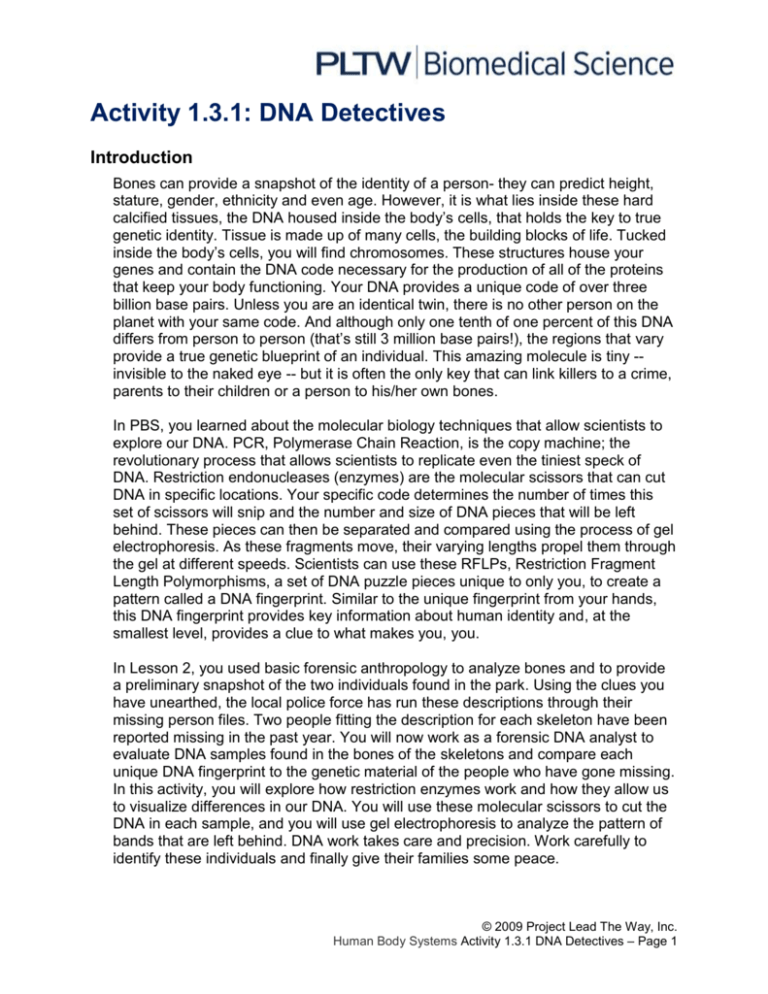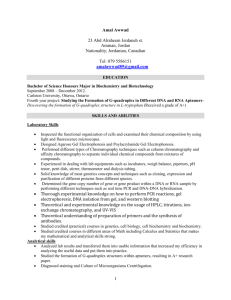A1.3.1.DNADetectives
advertisement

Activity 1.3.1: DNA Detectives Introduction Bones can provide a snapshot of the identity of a person- they can predict height, stature, gender, ethnicity and even age. However, it is what lies inside these hard calcified tissues, the DNA housed inside the body’s cells, that holds the key to true genetic identity. Tissue is made up of many cells, the building blocks of life. Tucked inside the body’s cells, you will find chromosomes. These structures house your genes and contain the DNA code necessary for the production of all of the proteins that keep your body functioning. Your DNA provides a unique code of over three billion base pairs. Unless you are an identical twin, there is no other person on the planet with your same code. And although only one tenth of one percent of this DNA differs from person to person (that’s still 3 million base pairs!), the regions that vary provide a true genetic blueprint of an individual. This amazing molecule is tiny -invisible to the naked eye -- but it is often the only key that can link killers to a crime, parents to their children or a person to his/her own bones. In PBS, you learned about the molecular biology techniques that allow scientists to explore our DNA. PCR, Polymerase Chain Reaction, is the copy machine; the revolutionary process that allows scientists to replicate even the tiniest speck of DNA. Restriction endonucleases (enzymes) are the molecular scissors that can cut DNA in specific locations. Your specific code determines the number of times this set of scissors will snip and the number and size of DNA pieces that will be left behind. These pieces can then be separated and compared using the process of gel electrophoresis. As these fragments move, their varying lengths propel them through the gel at different speeds. Scientists can use these RFLPs, Restriction Fragment Length Polymorphisms, a set of DNA puzzle pieces unique to only you, to create a pattern called a DNA fingerprint. Similar to the unique fingerprint from your hands, this DNA fingerprint provides key information about human identity and, at the smallest level, provides a clue to what makes you, you. In Lesson 2, you used basic forensic anthropology to analyze bones and to provide a preliminary snapshot of the two individuals found in the park. Using the clues you have unearthed, the local police force has run these descriptions through their missing person files. Two people fitting the description for each skeleton have been reported missing in the past year. You will now work as a forensic DNA analyst to evaluate DNA samples found in the bones of the skeletons and compare each unique DNA fingerprint to the genetic material of the people who have gone missing. In this activity, you will explore how restriction enzymes work and how they allow us to visualize differences in our DNA. You will use these molecular scissors to cut the DNA in each sample, and you will use gel electrophoresis to analyze the pattern of bands that are left behind. DNA work takes care and precision. Work carefully to identify these individuals and finally give their families some peace. © 2009 Project Lead The Way, Inc. Human Body Systems Activity 1.3.1 DNA Detectives – Page 1 Equipment Computer with Internet access Laboratory journal Edvotek DNA Fingerprinting II Kit o Predigested DNA from bone o DNA samples from missing persons o Restriction enzymes (EcoRI and HindIII) o Reaction buffer Microcentrifuge tubes 37°C water bath One agarose gel (0.8% agarose; 8 wells) Tris-Acetate-EDTA (TAE) gel electrophoresis buffer Gel electrophoresis apparatus Micropipettor (20 µl) Disposable micropipette tips Light box Safety goggles Lab apron Activity 1.3.1 Student Resource Sheet Procedure In this activity, you will continue work on the skeleton your team analyzed in Lesson 2. You will compare the DNA found inside of the bones of your skeleton to the two individuals who match the profile you have provided. DNA samples provided by the family of those who have gone missing will each be cut, or digested, with two restriction enzymes in separate reactions and will be compared to DNA isolated from the humerus of the unearthed skeleton. The DNA extracted from your skeleton has already been digested with these same two enzymes. PART I: DNA DIGESTION WITH RESTRICTION ENZYMES 1. Analyze DNA from the two individuals who have been linked to your skeleton: Missing Person #1 and Missing Person #2. 2. Obtain four, clean microcentrifuge tubes. All other reagents should be located at your lab station. 3. Label microcentrifuge tubes 1-4 for four restriction enzyme digestion reactions. Make sure to label each tube with the name of your group. Also, make sure to note the contents of each tube in your laboratory journal. You will process four DNA samples: o Tube 1- Missing Person #1 cut with Enzyme 1 o Tube 2- Missing Person #1 cut with Enzyme 2 o Tube 3- Missing Person #2 cut with Enzyme 1 o Tube 4- Missing Person #2 cut with Enzyme 2 © 2009 Project Lead The Way, Inc. Human Body Systems Activity 1.3.1 DNA Detectives – Page 2 4. Use the micropipettor to dispense 10µl of Enzyme Reaction Buffer into each of the four labeled tubes. 5. Add DNA and enzymes to tubes 1-4 according to the following information. Each tube will have a final volume of 40µl. Remember to use a fresh pipette tip for each transfer. You do not want to contaminate your samples. o Tube 1- 15µl DNA 1 + 15µl Enzyme 1 o Tube 2- 15µl DNA 1 + 15µl Enzyme 2 o Tube 3- 15µl DNA 2 + 15µl Enzyme 1 o Tube 4- 15µl DNA 2 + 15µl Enzyme 2 6. Cap each tube and gently tap the side of each tube to mix. Tap the tube gently on the desk to make sure all of the contents are in the bottom of the tube. 7. Incubate your tubes in a 37°C water bath for 45-60 minutes. Place your tubes in the bath as directed by your teacher. At the end of the incubation time, you will need to add 5µl of 10X gel loading solution to tubes 1-4 to stop the reaction. Depending on time, your teacher may complete this step for you. As your samples digest, continue with Steps 8 -10. 8. Obtain a Student Resource Sheet from your teacher. 9. With your partner, review the science behind restriction enzymes. Use the websites listed below to complete the questions and activities in Part A of the Student Response Sheet. o Dolan DNA Learning Center: Restriction Enzymes http://www.dnalc.org/ddnalc/resources/restriction.html o Access Excellence Classic Collection: Restriction Enzymes Background Paper http://www.accessexcellence.org/AE/AEC/CC/restriction.php 10. Review the process of gel electrophoresis by viewing the animations listed below. Use information from the sites to complete the activity described in Part B of the Student Response Sheet. o Genetic Science Learning Center – Gel Electrophoresis Virtual Lab http://learn.genetics.utah.edu/content/labs/gel/ o DNA Interactive: Gel Electrophoresis http://www.dnai.org/text/mediashowcase/index2.html?id=1014 PART II: GEL ELECTROPHORESIS OF RESTRICTION FRAGMENTS 11. If you are making the gel, follow your teacher’s instructions to melt and pour the agarose. 12. Remove the comb carefully from the agarose gel and place the gel in the electrophoresis chamber. 13. Fill the chamber with TAE buffer, making sure the gel is completely submerged. © 2009 Project Lead The Way, Inc. Human Body Systems Activity 1.3.1 DNA Detectives – Page 3 14. Obtain your sample tubes 1-4. Gently flick the side of each tube to mix the contents. Digested DNA samples from the bone and the standard DNA marker will be located at each lab station or table. 15. Heat the samples, including the standard DNA marker and the DNA extracted from bone, for two minutes at 65°C. Your teacher will direct you to the heat block or water bath. Allow the samples to cool a few minutes before loading them on the gel. 16. While your samples cool, practice loading samples on the practice gels. 17. When you are ready, load 40µl of each sample into the gel. Make sure to use a fresh tip for each sample. o Lane 1: Standard DNA Marker o Lane 2: DNA from Bone cut with Enzyme 1 o Lane 3: DNA from Bone cut with Enzyme 2 o Lane 4: Tube 1- Missing Person 1/Enzyme 1 o Lane 5: Tube 2- Missing Person 1/Enzyme 2 o Lane 6: Tube 3- Missing Person 2/Enzyme 1 o Lane 7: Tube 4- Missing Person 2/Enzyme 2 18. Draw a diagram of the gel in your lab notebook. Make sure to clearly indicate which sample is in which well. 19. Follow your teacher’s instructions to assemble the gel electrophoresis apparatus and connect the power supply. Be sure to check the orientation of your gel. The DNA containing wells should be closer to the negative pole and farther away from the positive pole. 20. Follow the teacher’s instructions to turn on the power supply. 21. Check the DNA samples 5 minutes after turning on the power supply. Make sure the loading dye is migrating out of the well and moving towards the positive pole. 22. Check your gel every ten minutes and turn off the power supply when the dye is near the bottom of the gel. The gel should take 30-45 minutes to run. During this time, continue work on the Student Resource Sheet. 23. When your gel is finished running, follow your teacher’s instructions to stain and visualize the DNA fragments. 24. Examine your results and make a sketch of the gel in your lab notebook. 25. Analyze the pattern of fragments that you see. Do the DNA fingerprints from the bone sample match up with either of the missing persons? Explain your findings in your lab notebook. 26. Return to the case report created by the forensic anthropologist. Add a new heading: o DNA Analysis: Referring to your gel electrophoresis results, clearly describe the findings of the DNA analysis. Make sure your explanation is clear (and well supported by what you see in the gel) © 2009 Project Lead The Way, Inc. Human Body Systems Activity 1.3.1 DNA Detectives – Page 4 and provide a clear conclusion as to the identity of the skeleton in the park. If possible, attach a labeled photograph of your gel to the completed case report. o Final Conclusion: Use information from the entire case to sum up the identification experience. 27. Answer the conclusion questions. Conclusion 1. Explain the relationship between the following words – cells, genes, chromosomes, tissues, DNA, proteins. 2. Explain why scientists probably used PCR when they prepared the DNA for your experiment. 3. In the space below, write a paragraph explaining what you would say to the other family to convince them that the science techniques used prove the bones do not belong to their loved one. © 2009 Project Lead The Way, Inc. Human Body Systems Activity 1.3.1 DNA Detectives – Page 5 4. Suggest reasons why it was helpful to digest each of your samples with two different restriction enzymes? How do the results of your gel reinforce this point? 5. Explain how the code in your DNA relates to your physical appearance as well as the functioning of your body. How might a change in this code impact the body? 6. Other than information from bone and from DNA analysis, what other characteristics/identifiers can be used to identify this skeleton? © 2009 Project Lead The Way, Inc. Human Body Systems Activity 1.3.1 DNA Detectives – Page 6





![Student Objectives [PA Standards]](http://s3.studylib.net/store/data/006630549_1-750e3ff6182968404793bd7a6bb8de86-300x300.png)

